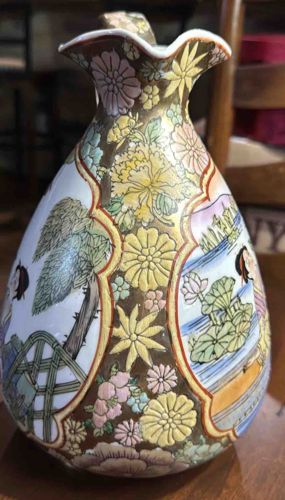
Japanese Satsuma-style Moriage Decorated Vase
This is a decorative ceramic vase, likely in the Satsuma-style, characterized by its intricately hand-painted and moriage (raised enamel) decoration. The vase has a bulbous body that tapers to a slender neck, and culminates in a fluted, wavy rim with delicate scalloped edges. The primary color palette includes soft pastels such as pink, yellow, blue, green, and orange, set against a rich, dark brown or gilt background in some areas, and a lighter cream/white background for cartouches. The design prominently features several distinct panels or cartouches, outlined in a reddish-orange and gold trim, which enclose narrative scenes. One visible scene depicts a figure by a body of water with lotus-like foliage, while another shows a tree with distinct bark and foliage. Between these pictorial panels are areas densely decorated with raised enamel floral motifs in yellows, pinks, and greens against a darker ground, creating a textured, almost three-dimensional effect. The moriage work is extensive and well-executed, indicating a skilled hand. The gold accents, particularly visible on the raised patterns and outlines, suggest a high level of craftsmanship and attention to detail. No obvious chips, cracks, or repairs are visible from the provided images, though a thorough inspection would be required to ascertain its full condition. The overall aesthetic points to a late 19th to early 20th-century Japanese origin, possibly Meiji or Taisho period, given the popularization of Satsuma ware during these eras for export.
AI-Generated Appraisal Disclaimer
Estimated Value
$400-600
Basic Information
Category
Ceramic Vase
Appraised On
December 7, 2025
Estimated Value
$400-600
Additional Details Provided By Owner
User Provided Information
Ceramic
Item Description
This is a decorative ceramic vase, likely in the Satsuma-style, characterized by its intricately hand-painted and moriage (raised enamel) decoration. The vase has a bulbous body that tapers to a slender neck, and culminates in a fluted, wavy rim with delicate scalloped edges. The primary color palette includes soft pastels such as pink, yellow, blue, green, and orange, set against a rich, dark brown or gilt background in some areas, and a lighter cream/white background for cartouches. The design prominently features several distinct panels or cartouches, outlined in a reddish-orange and gold trim, which enclose narrative scenes. One visible scene depicts a figure by a body of water with lotus-like foliage, while another shows a tree with distinct bark and foliage. Between these pictorial panels are areas densely decorated with raised enamel floral motifs in yellows, pinks, and greens against a darker ground, creating a textured, almost three-dimensional effect. The moriage work is extensive and well-executed, indicating a skilled hand. The gold accents, particularly visible on the raised patterns and outlines, suggest a high level of craftsmanship and attention to detail. No obvious chips, cracks, or repairs are visible from the provided images, though a thorough inspection would be required to ascertain its full condition. The overall aesthetic points to a late 19th to early 20th-century Japanese origin, possibly Meiji or Taisho period, given the popularization of Satsuma ware during these eras for export.
Get Your Items Appraised
Instant estimates of your treasures with AI-powered instant appraisals